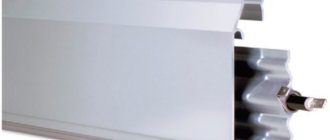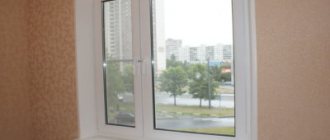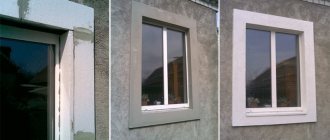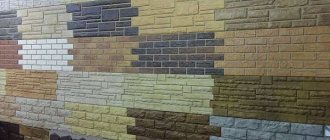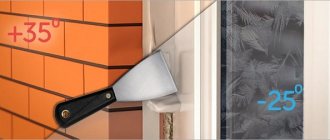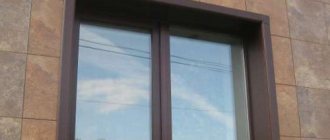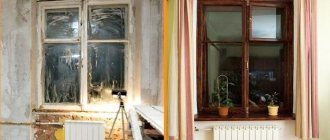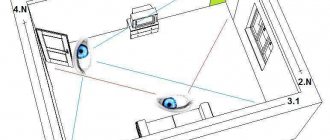Korovin Sergey Dmitrievich
Master of Architecture, graduated from Samara State University of Architecture and Civil Engineering. 11 years of experience in design and construction.
Owners of old window structures seek to replace them with new plastic windows, wanting to ensure good thermal insulation of the room. In practice, replacing a window is only the first step, which must be followed by a second - in the form of finishing and insulating the slopes. Positive results directly depend on how to insulate the slopes of plastic windows inside and out so that the operation of the new frames brings exceptional benefits to the owners.
Insulation of slopes - materials, types of work, price
Modern window designs reliably protect rooms from the penetration of cold air and noise
In order for the result of installing such windows to fully meet expectations, it is necessary to pay special attention to the slopes: they are the most vulnerable point
Insulating the slopes will not only keep the house warm and save on heating costs, but will also protect the mounting foam used when installing windows from the effects of an aggressive external environment, and will give the structure a beautiful finished look.
- 1 Choice of material: what to prefer?
- 2 Don't give the cold a chance
Choice of material: what to choose?
To equip warm slopes, the same materials are used that are used to insulate facades and walls. The most common and accessible are:
- Mineral or stone wool. It has excellent heat and sound insulation properties, is non-flammable, resistant to moisture and easy to use.
- Polystyrene foam is an inexpensive, practical and easy-to-use lightweight material with excellent thermal insulation properties.
- Extruded polystyrene foam is a modern modification of polystyrene foam, giving the material greater strength. It has low thermal conductivity, does not absorb moisture, is frost-resistant, resistant to mechanical stress and temperature changes.
- Sandwich panels are a pressed material consisting of two layers of rigid PVC with mineral wool or fiberglass insulation between them. Such panels do not allow cold to pass through, absorb noise, are resistant to dampness and are easy to use.
Any of the materials on the market copes well with the main task - insulation.
Don't give the cold a chance
There are two types of work on insulating window slopes: internal and external, and they must be carried out comprehensively.
For exterior work, mineral wool or extruded polystyrene foam is most often used. A primer solution is applied to the prepared surface, cleaned of dust and particles of polyurethane foam, which helps protect load-bearing structures, prevent the formation of fungus and mold, and improve the adhesion of materials. The insulation is secured using liquid nails, dowels and reinforcing mesh. Afterwards plastering work and painting of the finished flat surface are carried out.
When carrying out interior work, moisture-resistant plasterboard or sandwich panels are most often used to obtain the best results. The surface of the slopes is pre-prepared by analogy with exterior finishing work. Afterwards, a profile is installed around the perimeter, to which the drywall will subsequently be attached. The voids are filled with the selected thermal insulation material and foamed. The final stage of work is the installation of a decorative profile, corners and surface painting. It is recommended to treat the panel joints with liquid silicone.
Most companies providing window installation services perform insulation and slope work as part of the contract. But if you purchase double-glazed windows as an independent product, and not a comprehensive service, insulation and finishing will have to be done separately.
Despite the apparent simplicity of the work, it is better not to do the insulation of window slopes correctly yourself. This is especially true when it comes to complex window openings, for example, arched ones.
We are ready to offer you our services for insulating window slopes of any type at affordable prices. Our qualified specialists, who have many years of experience in this field, will quickly and efficiently carry out both external and internal insulation and finishing of window slopes of various configurations.
Internal slopes (plastic)
| Prices for complex finishing depending on the depth of the slope. | ||||
| Slope depth | Up to 25 cm. | 25 – 35 cm. | 35 – 50 cm. | 50 – 100 cm. |
| Prices per m.p. | 650 rub. | 750 rub. | 850 rub. | On request |
Arched slopes
| Prices for complex finishing depending on the depth of the slope. | ||||
| Slope depth | Up to 25 cm. | 25 – 35 cm. | 35 – 50 cm. | 50 – 100 cm. |
| Prices per m.p. | 840 rub. | 940 rub. | 1100 rub. | On request |
Street slopes
| Prices for complex finishing depending on the depth of the slope | ||||
| Slope depth | Up to 25 cm. | 25 – 35 cm. | 35 – 50 cm. | 50 – 100 cm. |
| Prices per m.p. | 840 rub. | 940 rub. | 1100 rub. | On request |
Laminated slopes
| Prices for complex finishing depending on the depth of the slope, lamination to match the color of the window profile. | ||||
| Slope depth | Up to 25 cm. | 25 – 35 cm. | 35 – 50 cm. | 50 – 100 cm. |
| Prices per m.p. | 1550 rub. | 1900 rub. | 2750 rub. | On request |
Selection of materials
An important point from which the whole process begins is the selection of materials. Manufacturers present us with a wide range of options that should be sorted out.
Thin foam
The cheapest and most common material. It is not difficult to use, but there are some peculiarities. Styrofoam tends to expand when exposed to heat, and a small amount of glue should be used to strengthen it. Otherwise, it risks cracking and losing its characteristics that allow it to store heat.
Foamed polyethylene foam
It is characterized by good insulating properties and is also moisture resistant. Polyethylene foam should only be taken with foil. When using this building material to finish a window, it is important to carefully seal the joints.
Mineral wool
Quite a practical material used in insulating slopes. Cotton wool provides high-quality thermal insulation of the frame, plus it has noise-protecting properties. Another important advantage is its resistance to moisture.
Sandwich panels
Relatively reliable material. Plastic panels have a layer of insulation. Their installation takes a short amount of time. In addition, sandwich panels are characterized by sound insulation and resistance to moisture. And they are easy to care for.
All these elements can be conveniently arranged. For example, if there is a fairly large unfilled space left after laying the foam, you can plug the gaps with mineral wool, additionally strengthening it with polyurethane foam.
Technology of work execution
Insulating window slopes from the outside requires step-by-step correct execution of the work and compliance with all rules and recommendations. At the initial stage, the surface is prepared, which is cleaned of dust and contaminants.
Next, the cleaned surface is carefully primed with a special primer, which is intended for exterior finishing work. At the next stage, measurements of the width of the slopes are taken and insulation of the required dimensions is prepared.
For finishing activities, the following equipment is needed, which includes a hammer drill, a screwdriver, fasteners, sealant, metal profiles, primer, adhesive solution, insulation, and building level.
Then, using a special glue or solution, the selected insulation is glued to the surface, which is additionally fixed with plastic dowels. They eliminate the formation of cold bridges and more efficient heat retention.
A reinforcing mesh is placed on top of the insulation for better and high-quality fastening, and at the final stage the surface is plastered or sheathed with a certain material.
Then proceed to the side parts of the window frame. In some cases, when there are large irregularities, it is necessary to install sheathing. Metal profiles are used for the frame, and the selected thermal insulation material is placed in the free space between the wall and the frame.
We recommend watching the video:
The best option for exterior window decoration is the use of metal panels or siding. They are characterized by increased strength and reliability, long service life, and resistance to various negative factors.
Expert recommendations
The insulation procedure is characterized by its peculiarities. Knowing the subtleties, you can avoid many problems. To ensure the highest quality work, adhere to the following rules:
- If there is no insulation of the required size, you can use separate pieces. They are placed tightly to each other.
- Ideal adhesion can be achieved through a combination of glue and reinforcing mesh.
- Preparatory work includes getting rid of cracks and defects. If the hole is larger than 3 mm, sealant must be used.
- Of all insulation materials, extruded polystyrene foam has the maximum thermal insulation function. This will be a plus when performing outdoor work.
- You need to choose thermal insulation based on the dimensions of the gaps. If the free space exceeds 4 cm, use polystyrene foam or polystyrene foam. If the gap is 2-3 cm - fiberglass, less than 2 cm - polyurethane foam, mineral wool.
You cannot take foam with a density of less than 30 kg/cubic meter. m. If you prefer mineral wool, the density should exceed 75 kg/cu.m. m. Otherwise, the insulation will not withstand the load and will quickly become unusable.
Internal insulation
The method of insulating slopes from the inside will depend on the window design option. If you are making a slope from plasterboard, then it is very convenient to use mineral wool or foam plastic for thermal insulation. You can also fill the space between sheets of drywall with special foam.
One of the most popular methods of internal insulation of slopes on windows is the installation of sandwich panels. They are mounted on profiles. Initially, it is necessary to measure the slopes and cut the guides. We cut off the vertical side and top profiles with an allowance of 2-3 cm. The profiles are attached to the wall with screws.
Initially, two upper profiles are attached parallel to each other, and then vertical side ones. You should also cut four more profile strips that will be attached horizontally to the two side window walls. First, we secure the top panel with screws to the profile, and then snap the rest onto it. They also need to be secured with screws. To give the window a more aesthetic appearance, profiles are also attached to the wall and the gaps are sewn up with them. The ends of the panels are cut at an angle of 45 degrees and glued to the wall.
Foam boards for insulating slopes on windows should be 2-3 cm thick. The insulation should be attached so that the installation seam is completely closed. The foam is placed on a special adhesive solution. Before finishing with foam plastic, it is necessary to attach a reinforcing mesh to the surface. Next, you need to install drywall. The seams between the gypsum board sheets are puttied. They can then be primed and painted.
It is not necessary to cover the slope with plasterboard if you use extruded polystyrene foam. After the material has been fixed and the solution has completely dried, the slabs are puttied and then primed. Next, you can paint the surface. If you use mineral wool for thermal insulation, then it must be additionally wrapped with foil. This will provide additional protection for the material from moisture. It is recommended to wear a mask and gloves when installing mineral wool, since the fibers of the material adversely affect human skin and respiratory tract.
Internal insulation should be carried out together with the installation of the window sill. Also, the air in the room should be dry. As you can see, insulating a window is not at all difficult. If you take into account all the finishing recommendations, you will be able to carry out this work yourself. By insulating the internal and external slopes of windows into the room, you will not only retain heat, but also protect it from moisture.
Why does a window need to be insulated and what materials to use?
The installation seam between the plastic structure and the wall is the weak point of the window opening. It is precisely because of poor-quality seam sealing that unpleasant phenomena occur in winter, namely:
- formation of frost in the corners of the slope (the presence of voids and “cold bridges” leads to freezing of the slope through and through)
- a large amount of condensation and ice on the glass (poor insulation brings the “dew point” to the inner surface of the glass, where condensation can freeze in severe frosts)
- stagnation of water on the windowsill (water draining from double-glazed windows collects on the windowsill)
- the appearance of mold and mildew (moisture-saturated foam and wall, comfortable conditions for them)
- whistling in slopes in windy weather (the reason for this phenomenon: voids facing the street)
- destruction of polyurethane foam under the influence of atmospheric phenomena (under direct sunlight, from moisture and freezing, this material literally crumbles)
To prevent apartment residents from being visited by such uninvited guests during the winter, the slopes should be properly insulated; it is better to do this immediately when installing a new window than to redo it after a year after surviving a difficult winter.
To insulate slopes you will need several types of materials:
- polyurethane foam
- silicone or liquid plastic
- sandwich board or plasterboard
- insulation directly
- plaster, putty
Insulation of slopes from the outside
The choice of each material should be approached with knowledge, because even polyurethane foam has its own characteristics.
For the installation of windows, foam with low secondary expansion is used so that the slopes do not swell due to excessive expansion of the foam layer.
For outdoor work, you need foam that is suitable for the temperature regime, that is, winter or summer.
Foam plastic, penoplex, fiberglass, mineral wool can be used as insulation.
These materials have their disadvantages and advantages.
Polystyrene foam is inexpensive and easy to work with, but this insulation absorbs moisture and retains it for a long time, which can lead to the appearance of mold and a damp smell.
Modern penoplex material is more expensive and does not absorb water. Fiberglass and mineral wool have good thermal insulation properties, their disadvantage is that they are difficult to work with.
The window must not only be thoroughly insulated, but also have a presentable appearance; plasterboard, 10 mm sandwich board or plaster are used for decorative finishing of the slope.
All these options have their place, but the most convenient to use and aesthetically pleasing are plastic boards with a foam layer between two sheets of thin PVC; this material is also insulation.
Drywall is a cheap option, but as you know, it is not resistant to moisture, and it also needs additional processing to achieve an attractive appearance. Plastering an internal slope requires skills, since the plane must be perfectly flat and smooth.
Liquid plastic for windows
To seal the joints between the slopes and the frame, silicone or liquid plastic is used.
The latter is more reliable; after hardening, it adheres firmly to the surface and provides insulation for a long time.
While silicone tends to peel off from the frame, especially in the presence of moisture.
The choice of materials depends on financial capabilities and on the practical need to use certain materials, for example, in a brick house with a quarter, polyurethane foam and a sandwich panel will be enough to install a window, while in a panel or wooden house additional insulation will be required.
Starting and finishing putty
Training video for beginners
How to prepare the solution was described above, but someone may express a desire to use a pasty acrylic or latex mixture - if a person has enough money, then this is very good. But I will still tell you how to work with starting and finishing gypsum mixtures.
After preparing the start, they pass along the beacons with this solution and here it is advisable to work with a large spatula or small spoon so that their length is enough for the width of the slope - this is especially important for beginners. Apply a 10-centimeter solution along the entire length of a large instrument (40 cm) and apply it to the surface, pulling it from bottom to top.
Then, using a small tool, remove the remaining solution from the large blade, add more and apply it to the wall - this is done until the finish is obtained without pits and scratches. For wallpaper, only a starting layer is enough, which is much more rational, since there are small pores there and the wallpaper will stick better.
Plastering window slopes
You can start applying the finishing layer only the next day, when the starting material has hardened (it is not necessary to wait until it dries completely). When plastering for painting, they use finishing putty - the powder is very fine and the surface is smooth, like a mirror. For the finish, a 1.5-2 mm layer is enough, unless of course the start was successful. I would like to warn you that this kind of putty consumes much less, so if you do not rely on your finishing speed, make a batch of about a quarter bucket of water and a quarter bucket of powder.
Note. During work, you need to constantly monitor the slope angle, since the putty will fall on the wall during plastering. It is simply removed with a spatula.
Special grater for grinding
When plastering work is carried out independently for the first time or there is simply very little practical experience, the tiled surface will not turn out to be perfectly smooth. This means that it will need to be sanded using a special grater with clamps, medium-grit sandpaper or a diamond mesh. To select sandpaper you need to know its marking, and according to GOST 3647-80 it can be from 4 to 80 with the letter H separated by a hyphen and the larger the number, the larger the grain. In our case, these are 20-H, 16-H, 12-H. In Europe, the marking corresponds to modern GOST 52381-05, where, in accordance with ISO 6344 standards, there is the letter P, followed by numbers from 24 to 600, only here a decrease in the number indicates an increase in grain. For grinding use P60, P80, P100 and P120. The same marking according to ISO 6344 applies to diamond meshes.
Note. There are electric grinding machines for such purposes, into which the same paper or the same mesh is inserted. But there is no point in purchasing it for the sake of slopes.
This is the cell of the P100 diamond mesh.
But grinding is grinding, and when can this be done so as not to spoil the whole work? Only when the plaster is completely dry, and this is easy to determine by the presence or absence of dark spots. They indicate places where moisture has accumulated, and if you go over them with sandpaper or a diamond mesh, scratches will remain on the surface. After this, it will not be possible to achieve a smooth surface - you will have to putty again.
Why is it necessary to insulate a window sill?
Rice. 2. Insulating the window sill will eliminate drafts
Most Russians believe that the issue of room insulation can be solved by installing PVC windows. However, to effectively retain heat in a residential or office space, absolutely all elements of the window opening must be used. This is especially true for the window sill. It is this element of the window structure that is considered the most vulnerable. Therefore, if the temperature in the room drops, first of all, you should check the area where the window frame adjoins the window sill. If cold air comes from there, causing drafts, then residents urgently need to address the issue of insulating this particular window structure.
This is interesting: How to choose cast iron batteries
Causes of condensation
Simply put, condensation forms where cold and warm air meet. Why does this happen at the edge of the glass unit, next to the slopes?
Since we are talking about metal-plastic windows, it becomes clear that metal conducts the body very well. If the window profile were entirely made of metal, it would provide virtually no protection to the room. To avoid this situation, polyamide inserts are used. By using hard plastic, the most important part of the task is achieved: getting rid of cold mystics.
A cold bridge is a section of the enclosing structure (in our case, a window profile) that has a reduced thermal resistance.
That is, in the case of the profile itself, we avoided heat leaks and cold air flow. Glass itself does not conduct heat well, so the junction of glass and frame, most often aluminum, becomes a kind of cold bridge. So it removes heat from the room and becomes a place where warm and cold air meet, falling out in the form of condensation at the edge of the window.
About the same thing happens on slopes. And the essence of the problem is connected with such a concept as an isotherm.
Isotherm (isothermal process) is a line of equal temperatures or a junction of temperatures that runs inside the wall.
Condensation occurs at the dew point. And if this indicator goes into the room, condensation forms there. In well-planned structures, of course, this does not happen, but this requires correct thermal calculations of the enclosing structures. Most often, the dew point is precisely on the slopes, because in this place the concrete layer has the smallest thickness. That is, in the case of a blank wall, the dew point is on the street, and in the case of a window opening, inside the room.
How to make an external slope - the wisdom of plastering
Windows facing a loggia or balcony can be protected with the same plastic panels that are installed from the inside. Accurate, fast and efficient. In addition, plastic products are ideally suited for plastic windows - they will look quite harmonious. The same cannot be said about wooden windows. The process becomes somewhat more complicated if you decorate the walls of your house with siding (block house, lining, metal or plastic siding).
In this case, you should select platbands directly for the finishing material - this should be done when choosing it, since suitable additional elements are often sold as a set. Plastering street slopes is the most time-consuming method. Although there are benefits from its use - consumables are inexpensive, and the result is quite durable. In addition, plaster provides additional thermal insulation.
Possible mistakes
- Do not cut parts exactly to your measurements if you are using foam for insulation. If they don't turn out to be the right shape, you won't have any stock left and will have to throw them away. It's not very economical.
- Mineral wool whose density is less than 75 kilograms per cubic meter cannot be used to insulate slopes. This material has too little ability to withstand loads and is not suitable for insulating windows.
- When choosing foamed polyethylene, it would be a mistake to ignore the advice on sealing joints in slopes.
- You cannot use foam whose density is less than 30-35 kg. per cubic meter.
These are all the nuances that need to be kept in mind when insulating window slopes.
Preliminary work before the main work
Before insulating plastic windows, a number of preparatory measures should be taken, which will eliminate the occurrence of problems in the future.
In addition, the foam is often not covered in any way on the outside of the building - as a result, the material rapidly loses its properties under the influence of sunlight, frost and precipitation. All this only means that the uncovered material itself does not prevent the penetration of cold and external sounds.
Sealing seams, especially on the outside, is the easiest way to prevent the window structure from blowing out
So, checking the foam comes down to a careful inspection of the assembly seam. It is advisable to do this in windy and frosty weather - this will help to quickly detect weak points that allow cold to pass through.
Identified deficiencies should be eliminated by applying a small amount of new material. There is no need to apply too much foam as it tends to expand when exposed to air, which can lead to unnecessary contamination.
After foaming all joints and seams, excess foam is removed and protected using various materials
After eliminating problems with installation seams, you should move on to the next stage - additional insulation of windows from the outside.
You can carry out the whole process yourself - the main difficulties arise if there are blind sashes on the window. In this case, you will have to remove the double-glazed window and then put it back - and it is better to entrust this operation to specialists.
How were windows thermally insulated before?
Until recently, drafts and blow-outs arising from defects in window openings were eliminated using a variety of improvised means. These included small rags, special paper, medical cotton wool, and adhesive tape.
Although this method provided the desired effect and was easy to implement with your own hands, the aesthetic appearance of the window after it was not the best. For example, when removing the same tape, entire pieces of wooden window coverings often came off. To fix the problem, the damaged surfaces had to be repainted.
This also applies to paper glued over frame slots. As for cotton wool and rags, such “heat insulators” often need to be picked out, they fit so tightly into the corresponding holes.
It is clear that it is advisable to leave such methods of insulating window structures in the past. They bring nothing but trouble. Not to mention that the slopes do not insulate at all. Meanwhile, these functional elements are of great importance when it comes to protecting plastic windows from the inside from the cold. What to do? The answer is obvious - use modern heat insulators.
Installation of external slopes - the fastest and most popular finishing methods
The easiest way to finish external window slopes is putty and painting. Some people get by with just painting, but this is wrong. A layer of paint should protect the foam and windows from atmospheric influences, but we must not forget that the paint itself is susceptible to them, so it must be renewed at least every 2-3 years. The quickest way to make external slopes with your own hands is by gluing plastic corners. They are attached to the corners with butyl sealant, and to the window with double-sided tape. Nevertheless, the plastic copes with its task - it covers the seals from direct sunlight, rain and wind.
For this purpose, galvanized metal is used, which has a special polyester coating. After measuring the window opening and the slopes themselves, a piece of metal of the required size is bent into a shape resembling the letter “Z”. The curved edges are attached to the window frame with self-tapping screws, and the seams are treated with silicone-based sealant. The color should be selected in combination with the color of the roof, windows or facade so that it is in harmony with the overall picture. For example, if the windows are wooden, then for finishing the slopes it is better to choose a color identical to the shade of the wood.
Necessary components and additional elements
For the external decoration of windows and window openings, in addition to the cladding material itself, various additional elements and components for plastic windows are used. Let's consider, using sandwich panels as an example, what may be required during the work process.
For outdoor work, it is most preferable to use white sandwich panels based on polystyrene foam or polystyrene foam
Insulation of slopes of plastic windows from the street
When installing windows, the gaps between the frame and the slope are sealed with polyurethane foam. Because foam degrades from ultraviolet rays, it must be protected. It is for this purpose that in most cases the slopes are additionally trimmed with PVC panels. But this is not their only function; PVC panels have an internal layer of thermal insulation, thanks to which they additionally protect the wall from freezing.
But when installing windows in the attic, customers do not always ask builders to insulate the slopes of plastic windows from the outside. Many people want to save money, others do not pay attention to this issue. Subsequently, they may encounter problems such as condensation on the double-glazed windows and fogging of the windows. We’ll tell you in more detail how to solve these problems on your own.
How to insulate the slopes of plastic windows under siding
Material such as siding should be used only as a finishing touch to a window facing the street. The main insulation should be done using polyurethane foam (sealing the seam between the frame and the slope) and polystyrene foam (insulating the slope from the street). Let us remind you that the PVC window frame should be covered from the outside with insulation or brickwork to 1/3 of its width.
This is the only way to protect yourself from the problem of windows fogging up in winter. Of course, other factors also influence the appearance of condensation - insufficient flow of warm air from the heating radiator or lack of ventilation in the attic of the house. But insulating the PVC frame from the outside will prevent freezing of the structure, and therefore will significantly reduce the heat loss of the room through the window opening.
How to insulate the slopes of plastic windows with foam plastic
If, when installing the window, the frame was not covered with brickwork, then you can protect the structure from freezing using polystyrene foam or extruded polystyrene foam. First, you should level the slopes with plaster and treat them with waterproofing. After this, the thermal insulation slabs are cut to the width of the slope and fixed to the surface using polystyrene foam or polystyrene foam adhesive.
The side and top of the outer slope should be finished with polystyrene foam. After thermal insulation of the window from the street with polystyrene foam, the insulation should be protected from sunlight and mechanical damage. To do this, you can use siding or PVC panels, which can also be installed on polyurethane foam. External corners on the wall are trimmed with plastic corners for aesthetics.
How to insulate the slopes of plastic windows with mineral wool
The use of basalt insulation requires the installation of high-quality vapor and waterproofing, which is very problematic to do on this structure. Constant exposure to cold and heat from both sides on mineral wool will lead to the material getting wet, and all the thermal insulation characteristics of mineral wool will be lost. An exception may be when you insulate the facade of the house with mineral wool under the plaster.
You can also use plaster to finish slopes with and without insulation. You can plaster the slopes from the street yourself. To finish polystyrene foam with plaster, first glue a painting mesh onto the thermal insulation, and then apply façade putty. Brick and concrete walls are first primed, and then facade putty or plaster is also applied to the surface.
How to insulate a window for the winter with your own hands
All measures to insulate a double-glazed window must be carried out before the onset of the cold period. Because materials such as dry mix and sealant should be used only at certain temperatures, as they may lose their properties. Air humidity should be optimal, there should be no draft. Insulation must be done simultaneously from the outside and inside.
Materials used Various materials and methods can be used here. Such as :
- Construction foam. It is the best means for window insulation. As it expands, all voids are filled. But the foam must be protected from direct UV rays and temperature fluctuations.
- Using mineral wool. It has good thermal insulation properties.
- Polystyrene foam or polystyrene foam for insulation of slopes.
Note: Rigid insulation is used in cases where the installation seam is no wider than three millimeters. In others it is better to use mineral wool.
Silicone sealant is used when processing plastic parts of windows to eliminate blows. Using dry mixtures, slopes on the street side are insulated. Construction tape is used instead of sealant or on top of it.
External insulation
External insulation work includes insulation of the slope and ebb on the street side. If insulation of the outer slope has not been done previously, then all actions will be useless. After time, the window will still be blown out, in addition, the inner wall may become damp and moldy. Caulking the external cracks will not lead to anything, because the plaster and foam will gradually become unusable.
How to insulate slopes
For thermal insulation of warm slopes for plastic windows, use:
- Styrofoam. The material has zero vapor permeability and does not release steam from the room. Has thermal insulation parameters. It has a porous structure and can accumulate moisture inside.
- Extruded polystyrene foam. Used for external insulation. When exposed to high temperatures, it releases harmful substances.
- Mineral wool. It has high vapor permeability and absorbs moisture. Rigid (facade) slabs do not shrink and have poor thermal conductivity. Non-rigid slabs shrink over time. This leads to the appearance of voids in which air convection will take place.
- Sandwich panel. This is a composition of insulation and facing material. Used for external and external types of insulation.
- Penoplex. An analogue of polystyrene foam with the same properties. Designed for insulation of internal and external slopes. Resistant to moisture.
You can insulate slopes from the street by plastering followed by painting. When performed correctly, the method provides hydro- and thermal protection. Suitable for processing window frames made of plastic and wood. Decorative plaster exhibits the same properties.
Foam plastic is recommended to be chosen by users who do not have the skills to insulate slopes. The material is inexpensive, you can perform the necessary tasks yourself.
When working with mineral wool, safety precautions must be observed. The material has a brittle structure and low mass. Small pieces of cotton wool may become suspended in the air. To ensure complete protection, it is recommended to perform the warming procedure wearing a respirator and gloves.
Inside
Having decided on the material, you can move on to the internal insulation of the slopes.
The first step is to do the preparatory work:
- Remains of polyurethane foam are removed from the surface of the window;
- treated with a primer with antibacterial properties. This will protect the structure from formations such as mold and fungi;
- plastering the surface. The layer of plaster should be even. It is necessary to clean the work area and treat the surface with a primer;
- laying thermal insulation material.
After the window slope is insulated, it is necessary to allow the structure to dry. After this, you should putty the corner and apply a finishing coating (plasterboard covering, painting, plastering).
Thermal insulation material should not have a smooth structure. In order for it to stick to the slope, you must first scratch the surface. Good adhesion is ensured and air does not enter the structure.
Outside
Insulating the slopes of plastic windows from the outside faces problems, especially in multi-storey buildings. Insulation from the outside of the window occurs in several stages:
- When installing the structure, the remaining foam is removed. The surface is treated with a primer and antibacterial solution;
- if the slopes are uneven, you will have to plaster the surface;
- the material is cut into fragments and fixed to the slope with glue. To increase strength, the thermal insulation is secured with dowels paired with mushroom-shaped screws. They provide strong adhesion and do not damage the structure of the material;
- a protective corner is installed, glue and a fiberglass mesh are applied. The surface is carefully leveled, another layer of glue is applied;
- After complete drying, the slope is covered with water-based paint or plaster.
The outer part of the slope, made of foam plastic, paint and plaster, will protect the home from heat loss. The element is located at a slight angle; moisture will not accumulate on the window.
Read with this
- Window slopes made of plastic: self-installation
- How to insulate windows for the winter with your own hands: plastic and wooden
- Window without impost
- Insulating windows for the winter with masking tape and other materials
- How to choose self-adhesive insulation for windows and stick it correctly
- Window installation
- Instructions for use. Cosmofen glue: instructions for use
- Using tape to insulate windows
- How to use a Karcher long-handled window cleaner
- 10 proven ways to insulate windows for the winter with your own hands
We insulate the outside
For owners of apartments in high-rise buildings, it is always better to entrust the insulation of the slopes of plastic windows from the outside in the absence of a balcony to professional installers in order to avoid possible risks of falling from a height. If you have a balcony, do not forget about insurance and caution. Scheme of insulating a slope from the outside with a mini-slab
Scheme of insulating a slope from the outside with a mini-slab
So, how to properly insulate slopes from the outside:
- In the case of a new installation, first remove excess polyurethane foam and treat the surface with a primer that protects against fungus and mold.
- Plaster will be required if the window slopes are uneven.
- To improve thermal insulation, we choose Penoplex insulation. We cut the material into pieces of the required size, apply special glue and glue it to the surface. For strength, Penoplex can be secured with dowels with mushroom-shaped screws. Such parts do not break the structure of the material and hold it well on the vertical surface of the plastic window.
- Next comes the installation of a special corner.
- We apply glue to the insulated external slopes and place a fiberglass mesh in it, carefully leveling the surface. Let it dry a little and apply another layer of glue, then level it with a spatula.
- After the surface has completely dried, apply water-based paint.
The outer side of polystyrene foam, a layer of plaster and paint will not allow cold air to penetrate into the room, and warm slopes from the inside will shift the dew point towards the outer walls. After completing the street and interior work, the installation of warm slopes on the windows can be considered complete. Don’t forget: how to insulate the slopes of plastic windows from the street will largely determine the amount of heat in the room in winter, so take the time to carry out the technology according to all the rules and avoid alterations in the future.
